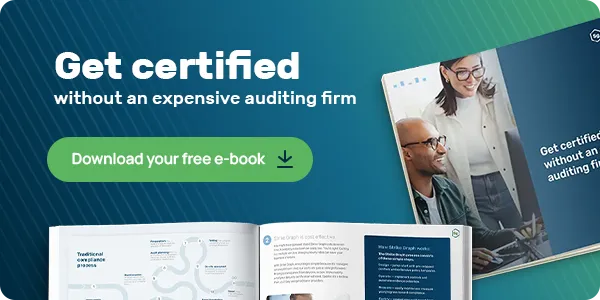Approaching the SOC 2 audit process can be overwhelming if you’re new to the procedure, especially if you’ve been tasked with getting your business SOC 2 compliant ASAP.
However, with a little insight into how audits work, you can be confident in pursuing SOC 2 compliance. So, let’s dive right in.
What is the SOC 2 audit process?
SOC (Service Organization Control) 2 is a security framework established by the AICPA (American Institute of Certified Public Accountants) that provides a set of guidelines by which to evaluate the security controls of service-oriented businesses. These businesses might include cloud service providers, SaaS companies, payment processing firms, or any organization that handles sensitive information.
SOC 2-compliant companies build trust with their customers, stakeholders, and investors by demonstrating that their security controls are in place and operating efficiently. Not to be confused with SOC 1, which is built around financial controls, the SOC 2 framework focuses on controls such as security, confidentiality, and privacy.
The end result of an audit is a report outlining the auditor’s assessment of the company’s controls. The auditor will present in their report an “unqualified opinion,” which is the highest level of assurance that a company is SOC 2 compliant. Otherwise, the report will suggest changes you must make to become compliant.
Below, we’ll outline all of the audit process steps plus a new, better way of reaching compliance.
How to prepare for the SOC 2 audit process
Though the SOC 2 audit process can be time-consuming and complex, if you take the right steps from the start, you’ll be more likely to have success. We recommend reading until the end of the article so you can understand the best options available when you’re ready to proceed.
Before moving into these steps, familiarize yourself with the framework. If you’re looking for resources to stay informed, our resource library is available so you can learn what you need to know about SOC 2 compliance.
There are five steps to preparing for your SOC 2 audit.
1. Define your scope and objectives.
An excellent place to start is with the reason behind the audit. For example, compliance is required to sign a new business contract or to meet updated regulatory requirements. Defining your objectives early on will help you and the auditing team drive progress in the right direction.
You can then proceed to examine which systems and data you’ll be assessing. This is essentially what you’ll reference to establish the scope of the audit along with which Trust Services Criteria (TSC) you choose.
2. Select your Trust Services Criteria.
Trust Services Criteria are the specific requirements that service organizations must meet to achieve SOC 2 compliance. They’re broken down into five categories that you’ll select based on your goals: security, availability, processing integrity, confidentiality, and privacy. These are covered in more detail in our post detailing a SOC 2 audit report example.
3. Document your processes and procedures.
The importance of the documentation process is hard to overstate as it will provide the backbone of a thorough examination of your controls. If you don’t already have them, this is the time to create detailed process flows that include what steps to take, who is responsible, and a timeline of how long it takes to complete.
This does not just apply to internal workflows but workflows involving third-party vendors and other external businesses, as well. You can work closely with your teams to ensure accuracy and to detail whatever risks might be present and the subsequent controls.
4. Perform a readiness assessment.
A readiness assessment is a crucial step in the SOC 2 audit process that helps you determine your level of preparedness for the actual audit. An auditor typically conducts a readiness assessment, which usually involves reviewing your documentation, assessing your risks and controls, and making any recommendations for you.
5. Address gaps.
You can make changes to your controls and procedures based on the readiness assessment before the official audit. Some controls may need minor changes, while you may need to rework others entirely. The good news is you’re addressing the issues now and potentially saving time and money when the proper audit begins. For example, a growing trend in the SaaS and cloud computing industries is unstructured data, a notable risk that must be addressed with the necessary controls before the audit.

The SOC 2 audit process — two options
Historically, there’s only been one way to establish compliance: through traditional auditing firms. However, as technology has advanced, these firms have largely remained unchanged and stuck in their old ways.
What Strike Graph offers is a tech-driven, faster, and more cost-effective solution that makes those old approaches obsolete. But before we get into that, let’s take a closer look at the old-school path to certification.
The antiquated way of seeking SOC 2 compliance
- 1. Engage with a licensed CPA to perform the audit. Yes, they’ll explain some things to you but you’ll mostly have to rely on them to make progress (by design). They charge high hourly rates for a process that will be prolonged because that’s how they’ve always done it, they’ll say.
- 2. Review the scope and objectives with the CPA. With the right planning as mentioned earlier, this will already be established and refined thanks to the readiness assessment.
- 3. Develop the project plan. The CPA will work with you to create a plan that assesses your risks and controls in light of your objectives, goals, and the Trust Services Criteria you’ve selected.
- 4. The testing phase. At this point everything is tested and carefully examined although you may not fully be aware of what is being tested and what they’re looking for.
- 5. Document the results. The CPA will document the results and make note of important observations here but they aren’t obligated to share everything they find with you, only what is pertinent to the audit report.
- 6. Receive the SOC 2 audit report. Finally, the CPA will prepare a SOC 2 audit report containing information on their approach, a description of risks and controls, the results of their testing, their conclusions, and their opinion.
The new way of seeking compliance
Strike Graph’s integrated certification platform is designed to streamline the auditing process as much as possible, all while being maximally transparent, convenient, fast, and cost-effective.
You go from start to compliance without the need for an auditing firm. Here’s how:
- 1. You design and operate your security program on the Strike Graph all-in-one platform.
- 2. Our assessment team uses tech-enabled testing methods to objectively measure if you’re meeting the SOC 2 requirements.
- 3. Our independent CPA verifies the results and writes your attestation, and that’s it — you’re compliant.
If you thrive when things are simple and you’re interested in saving money and valuable time (or perhaps even pursuing HIPAA compliance alongside SOC 2), Strike Graph is the smartest way to get SOC 2 compliant.
.jpg?width=1448&height=726&name=Screen%20Shot%202023-02-09%20at%202.57.5-min%20(1).jpg)










